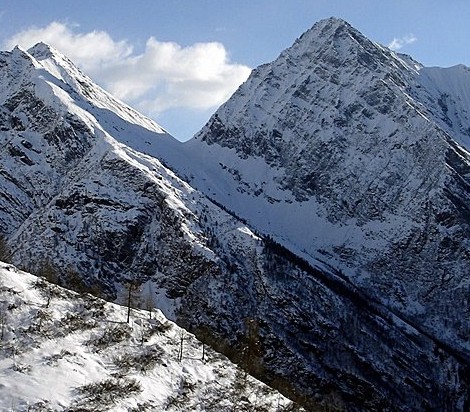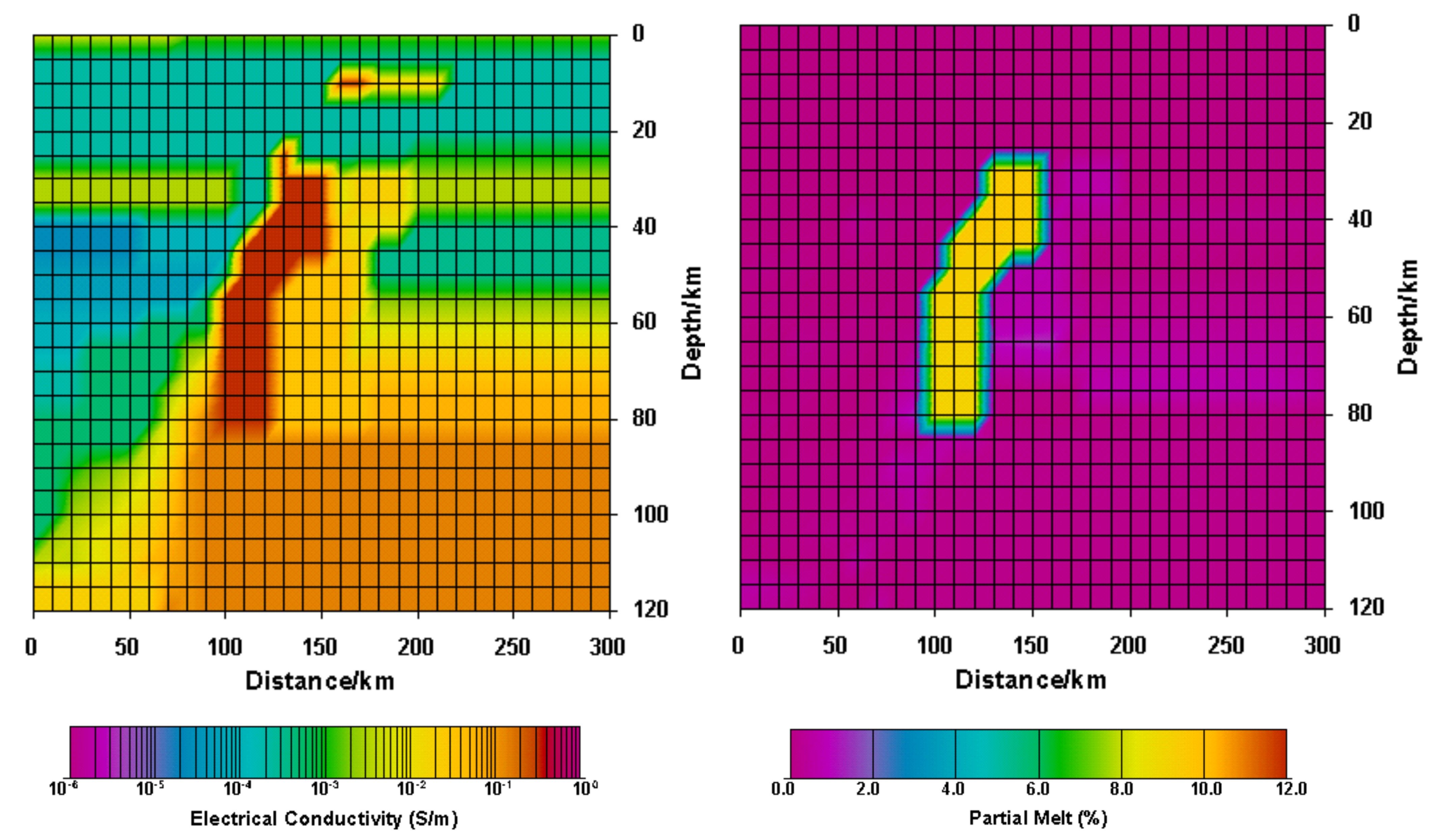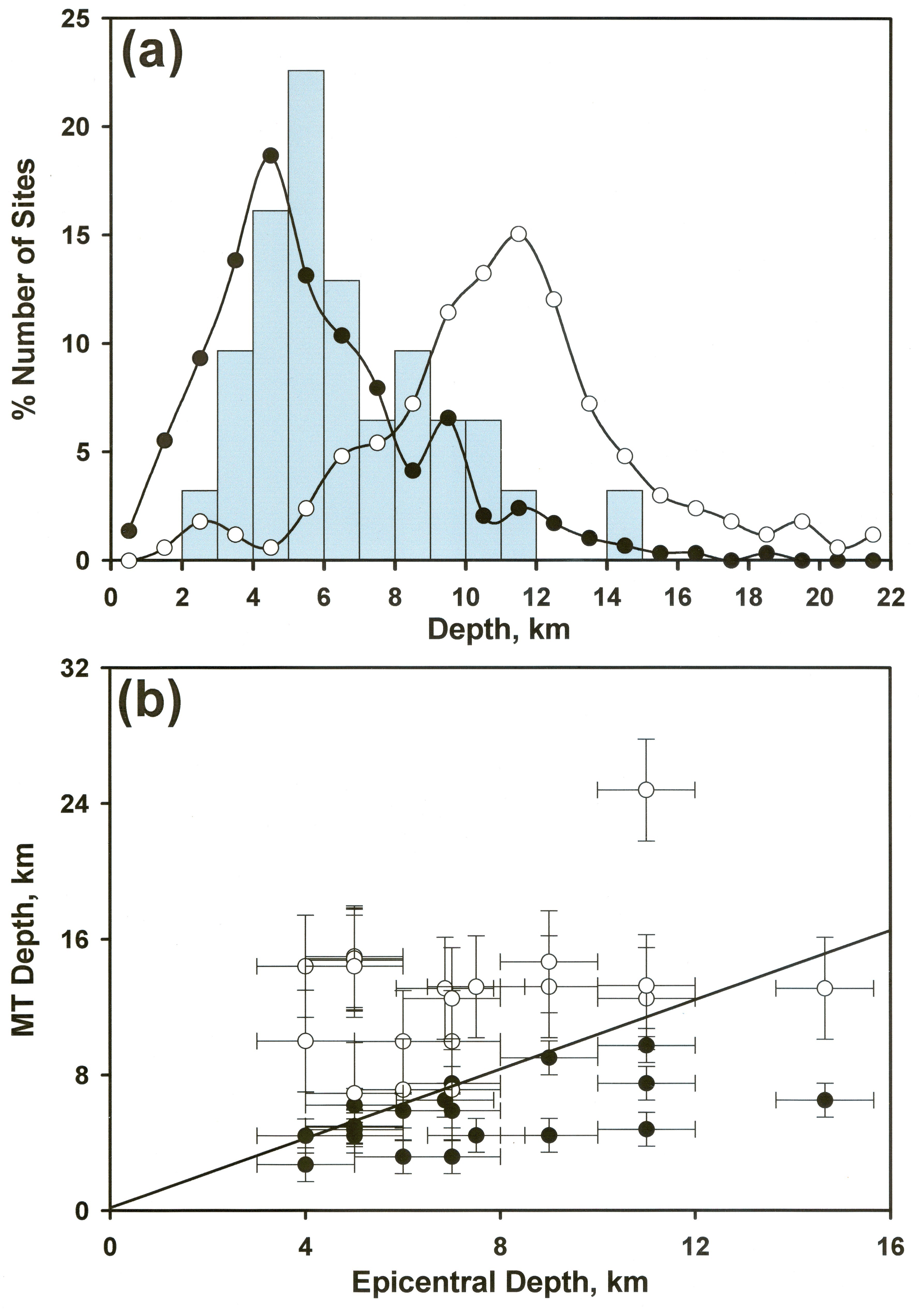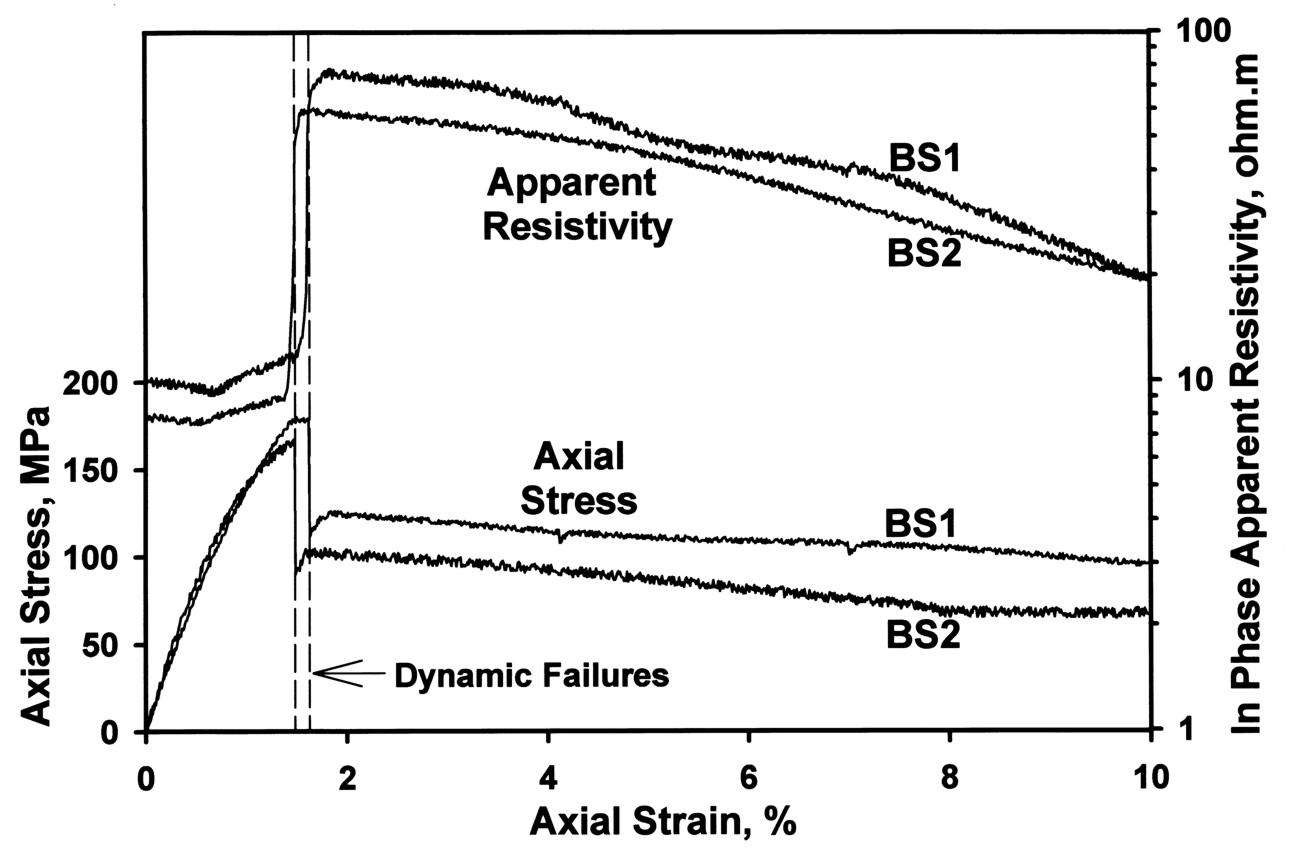

Electrical Conductivity of the Earth`s Crust
Since 1984 I have been interested in the interpretation of the apparent zones of high conductivity in the lower crust that are observed by MT measurements. The research has supported my hypothesis that there is a large number of different sources of high conductivity (aqueous fluids, graphite, partial melt etc) and that each is responsable for high conductivity zones in the lower continental crust.
 Amphibolite
and conductivity in the lower crust. The initial research took
crustal rock samples to lower crustal conditions, and showed that certain
rocks were capable of providing sufficiently high conductivities while others
were not. It was the amphibolite facies rocks that could provide sufficiently
high electrical conductivities and these are found in the upper part of the
lower crust which is where the highest conductivities are usually found. The
anhydrous granulite facies rocks of the lower part of the lower crust provided
much lower resistivities, which is also mirrored in the field MT results.
Amphibolite
and conductivity in the lower crust. The initial research took
crustal rock samples to lower crustal conditions, and showed that certain
rocks were capable of providing sufficiently high conductivities while others
were not. It was the amphibolite facies rocks that could provide sufficiently
high electrical conductivities and these are found in the upper part of the
lower crust which is where the highest conductivities are usually found. The
anhydrous granulite facies rocks of the lower part of the lower crust provided
much lower resistivities, which is also mirrored in the field MT results.
Thus we can say that certain fluid saturated rocks are able to provide the observed high crustal conductivities.
Mountains near the Ivrea Zone - a lower crustal exposure whence came some of our lower crustal samples.
Graphite and reconnection in the crust. Another set of rocks that was studied contained graphite. Graphite is another possible source of lower crustal conductivity. Some love it, some hate it. I believe that it is an important contribution to the overall picture for some areas. It was thought that graphite-bearing rocks had low conductivities due to rupture of the carbon films that coat the grain surfaces when they are exhumed from depth. We discovered that we could reconnect the carbon films by putting the rocks under pressure. By returning the rocks to the pressure at which they were subjected at depth, the conductivity returned to the high values it had there.
This finding made graphite a serious contender as a source of lower crustal conductivity.
Partial melt modelling in the Pyrenees. In a modelling study we were able to show that the most likely cause of the high conductivities observed in an ancient subducted slab beneath the Pyrenees is partial melting. We were able to put bounds on the fraction of partial melt in the slab and its connectivity as well as predicting that the Pyrenees will have volcanism in the future if it passes into an extensive regime.
Partial melting is therefore also a possible source of lower crustal high conductivity.
 The
observed electrical conductivity under the Pyrenees (left) together with the
calculated partial melt fraction for an inversion based upon Hashin-Shtrikman`s
upper bound (right).
The
observed electrical conductivity under the Pyrenees (left) together with the
calculated partial melt fraction for an inversion based upon Hashin-Shtrikman`s
upper bound (right).
Graphite and earthquakes in Hungary. We are about to publish data that correlates the high conductivity zone beneath Transdanubia with the earthquake distribution in the area. We make the hypothesis that the cause of the high conductivity is carbon that lines the fractures at depth. The graphite also lubricates the fractures and causes the earthquake distribution. Furthermore, laboratory experimentation indicates that shearing of a carbon-bearing fracture tends to smear the carbon which leads to a greater electrical conductivity in the direction of shearing and increased lubrification. The shearing leads to a positive feedback mechanism that causes the fracture to become weaker and more conductive.
 Left:
A comparison of the distribution of earthquakes and the high conductivity
zone in Transdanubia. (a) The depth distributions of the top (solid symbols,
284 sites) and base (open symbols, 171 sites) of the high conductivity zone
derived from MT observations depth distribution of earthquake focal depths
in the same area (grey bars, 31 events). (b) Location by location analysis
of the depth to the top (solid symbols) and base (open symbols) of the high
conductivity zone derived from MT observations as a function of focal depth.
Note that for all events to occur within the high conductivity zone the 1:1
line should separate the open and solid symbols. Errors discussed in the text.
Left:
A comparison of the distribution of earthquakes and the high conductivity
zone in Transdanubia. (a) The depth distributions of the top (solid symbols,
284 sites) and base (open symbols, 171 sites) of the high conductivity zone
derived from MT observations depth distribution of earthquake focal depths
in the same area (grey bars, 31 events). (b) Location by location analysis
of the depth to the top (solid symbols) and base (open symbols) of the high
conductivity zone derived from MT observations as a function of focal depth.
Note that for all events to occur within the high conductivity zone the 1:1
line should separate the open and solid symbols. Errors discussed in the text.

The decrease in resistivity and in fracture strength (axial stress) for two samples of carbon-rich black shale. Experimentally determined axial stress and in-phase apparent electrical resistivity at 1 kHz as a function of axial strain during the progressive axial deformation of two samples of carbon-bearing black shale. BS1 8.12% wt/wt carbon, BS2 10.06% wt/wt carbon.
Publications
Glover, P.W.J., F.J. Vine, R.G. Ross, & G. Turner, The measurement of electrical resistivity of rocks under simulated crustal conditions, In High Pressure Geosciences and Materials Synthesis, Ed. H. Vollstädt, Akademie Verlag, Berlin, 46 49, 1988.
Glover, P.W.J., Ross, R.G. & Jolly, H., The measurement of saturated rock electrical conductivity at lower crustal temperatures and high pressures, High Press. Res., 5, 705 707, 1990.
Glover, P.W.J., Vine, F.J. & Ross, R.G., Measurements of saturated basic and acidic rock electrical conductivities at lower crustal temperatures and high pressures, High Press. Res., 5, 735 737, 1990.
Glover, P.W.J., & Ross, R.G., A method of measuring the electric conductivity of saturated rocks in a high pressure cell subjected to high temperatures, High Temp. High Press., 22, 533 539, 1990.
Glover, P.W.J. & Vine, F.J., Electrical conductivity of carbon bearing granulite at raised temperatures and pressures, Nature, 360, 723 726, 1992. [pdf]
Glover, P.W.J. & Vine, F.J., Electrical conductivity of the continental crust, Geophys.Res.Lett., 21(22), 2357 2360, 1994.
Glover, P.W.J. & Vine, F.J., Beyond KTB Electrical conductivity of the deep continental crust, Surveys in Geophysics, 16, 5 36, 1995.[pdf]
Glover, P.W.J., Graphite and electrical conductivity in the lower continental crust: A review, Phys.Chem.Earth, 21(4), 279-287, 1996.[pdf]
Glover, P.W.J., Pous, J., Queralt, P., Muńoz, J.-A., Liesa, M. & Hole, M.J., Integrated two dimensional lithospheric conductivity modelling in the Pyrenees using field-scale and laboratory measurements, Earth Planet. Sci. Lett., 178(1-2), 59-72, 2000. [pdf]
Glover, P.W.J., Hole, M.J. & Pous, J., A modified Archie's Law for two conducting phases, Earth Planet. Sci. Lett., 180(3-4), 369-383, 2000. [pdf]
Glover, P.W.J. & Adám, A., Correlation between crustal high conductivity zones and seismic activity and the role of carbon during shear deformation, 2008, J. Geophys. Res., 113, B12210, doi:10.1029/2008JB005804. [pdf]
Presentations
Glover, P.W.J., F.J. Vine, R.G. Ross, & G. Turner, The measurement of electrical resistivity of rocks under simulated crustal conditions, 25th EHPRG International Conference on High Pressure Geosciences and Material Sciences, 25 27 August 1987, Potsdam, East Germany, 1987.
Glover, P.W.J., R.G. Ross, & H. Jolly, The measurement of saturated rock electrical conductivity at lower crustal temperatures and high pressures, 12th AIRAPT & 27th EHPRG International Conference on High Pressure Science and Technology, 17 21 July 1989, University of Paderborn, Germany, 1989.
Glover, P.W.J., F.J. Vine, & R.G. Ross, R.G., Measurements of saturated basic and acidic rock electrical conductivities at lower crustal temperatures and high pressures, 12th AIRAPT & 27th EHPRG International Conference on High Pressure Science and Technology, 17 21 July 1989, University of Paderborn, Germany, 1989.
Glover, P.W.J. & F.J. Vine, Electrical conductivity measurements made under hydrostatic pressure, High Pressure Technology Association one day discussion meeting on High Pressure Research in Earth Sciences, University College London, 5th July 1990, 1990.
Glover, P.W.J., Electrical conductivity of graphite bearing lower crustal rocks at lower crustal temperatures and raised pressures, 18th General Assembly of the European Geophysical Society, 1993.
Glover, P.W.J., Graphite and electrical conductivity in the lower continental crust: A review, 13th IUGG Workshop on Electromagnetic Induction in the Earth, July 12-18 1996, Onuma, Hokkaido, Japan, 1996.
Glover, P.W.J., High Electrical Conductivity in the Earth`s Continental Crust, Symposium of the Assistant Professor`s Society of the University of Tohoku, University of Tohoku, Sendai, Japan, May 1996.
Glover, P.W.J., Graphite and electrical conductivity in the lower continental crust: A review, 21st General Assembly of the European Geophysical Society, 1996.
Glover, P.W.J., Causes of High Electrical Conductivity in the Continental Crust, Technical University of Berlin Seminar, Technical University of Berlin, Germany, May 1997.
Glover, P.W.J., Causes of High Electrical Conductivity in the Continental Crust, University of Göttingen Seminar, University of Göttingen, Germany, May 1997.
Glover, P.W.J., Causes of High Electrical Conductivity in the Continental Crust, Free University of Berlin Seminar, Free University of Berlin, Germany, May 1997.
Glover, P.W.J., Causes of High Electrical Conductivity in the Continental Crust, University of Frankfürt Seminar, University of Frankfürt , Germany, May 1997.
Glover, P.W.J., Electrical conductivity in the Earth`s crust; A review of data and mechanisms, Aberdeen Geological Society Seminar, April 1998.
Pous, J., P.W.J. Glover, J. Muńoz, P. Queralt, M. Liesa & M.J. Hole, Partial melt fraction determination in the Pyrenees using magnetotelluric and laboratory data, 24th General Assembly of the European Geophysical Society, 1999.
Glover, P.W.J., Hole, M. & Pous, J., A modified Archie's law for two conducting phases, 25th General Assembly of the European Geophysical Society Nice, France, 25-29th April, 2000. [pdf]
Glover, P.W.J., Pous, J., Muńoz, J., Queralt, P., Liesa, M. & Hole, M., Integrated lithospheric conductivity modelling in the Pyrenees using laboratory and field data, 25th General Assembly of the European Geophysical Society Nice, France, 25-29th April, 2000.[pdf]
Glover, P.W.J., Ádám, A. & Zsiros, T., Correlation between crustal high conductivity zones and seismic activity and the role of carbon during shear, Poster, GAC-MAC-SEG-SGA 2006, Abstract No. 756, 14-17 May 2006.[pdf]
© Copyright, Paul Glover 2008: Last updated 14/11/2008